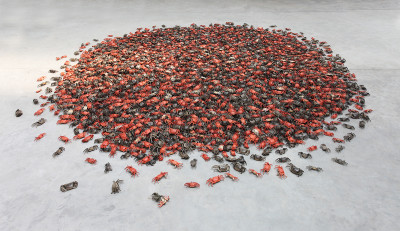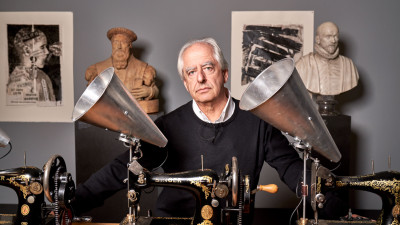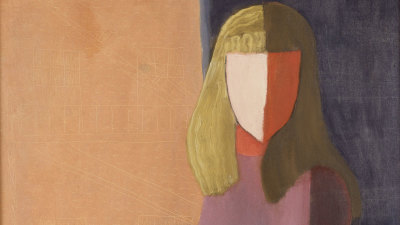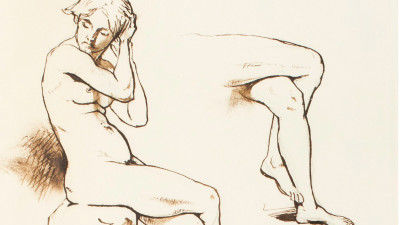Ai Weiwei: a beginner’s guide
Ai Weiwei: a beginner’s guide
By Louise Cohen
Published 14 September 2015
From surveillance cameras to smashed ceramics, Ai Weiwei is uncompromising in his fight for the freedom of expression. Here’s what you need to know about China’s most famous artist.
-
His father was a famous poet
Ai Weiwei was born into China’s cultural avant-garde, his mother a writer and his father an artist and activist. But after Ai Qing returned to Shanghai from studying painting in Paris in 1932, he was jailed for leftist leanings by the Nationalist government. Unable to paint in prison, by the time he was released three years later he was famed for the poetry he had written behind bars – now considered a pillar of Modern Chinese literature. Read Ai Qing’s obituary in the Independent
He grew up in exile
Ai Weiwei’s first 20 years were spent in harsh confinement – now at the hands of the Communist government. Ai Weiwei’s father had joined the Communist Party after his release from prison, and become a confidante and poet to Mao Zedong as the People’s Republic of China was founded. But in 1957, the year Ai Weiwei was born, such literary expressions were deemed threatening and Ai Qing was denounced as a rightist. Banned from writing and exiled first to north eastern China then to the north west, he was forced into hard labour while the family lived in an underground, rat-ridden shed. Education was scarce for Ai; his father’s extensive collection of books was burned, but for one French encyclopaedia which he’d annotate and relay to his son. The family were only allowed to resettle in Beijing 20 years later, when Mao died in 1976.
-
-

“The most daring artist in China”
Today, those roots have branched into a career more expansive, provocative and unapologetic than any of Ai Weiwei’s contemporaries. “He is the most daring and aggressive artist in the stand against official China,” Uli Sigg, a renowned collector of Chinese art, told RA Magazine. “Other Chinese artists are subtle in their subversion, or avoid directly speaking out. In his directness and fearlessness he is set apart.”
Ai has campaigned for human rights since his student days – his Beijing troupe of artist-activists, The Stars, were getting their exhibitions shut down by police as early as 1979 – but it was in 2008 that he reached a global audience. Following Sichuan’s devastating earthquake, the artist attempted to name all the children who were killed due to substandard construction of their schools, while the government remained silent. He eventually published a list of over 5000 online – which saw his volunteers arrested, his blog shut down and a brutal beating for Ai. Nonetheless, he went on to make Straight, 2008-2012, a 90-tonne assemblage of reinforcing steel bars reclaimed from the site of the collapsed buildings and hammered back straight. This installation will be the heaviest work ever to sit in our galleries. Ai discusses the work in this video.
-
-
2008 was also the year he collaborated with architects Herzog and de Meuron to design Beijing’s “Birds Nest” Olympic Stadium – but Ai’s disgust at the government’s self-promotional rhetoric and continued disregard for human rights led him to publicly boycott the Games. Read his opinion piece in the Guardian.
Ai himself sees no division between his art, his life and his politics. “I have to face my reality. My father and his whole generation were victimised by this political struggle, and today I’m also restricted… So it’s not by choice, it’s my life, and if I have to sacrifice for that I would have no regrets,” he told Tim Marlow, the RA’s artistic curator, on a visit to Beijing earlier this year.
-

Ai Weiwei, Straight, 2008–2012.
Steel reinforcing bars reclaimed from buildings collapsed in the Sichuan earthquake. 1200 x 600cm. Courtesy of Ai Weiwei Studio. Image courtesy of Ai Weiwei Studio © Ai Weiwei.
-
He has a dash of Duchamp
Brought up on the writings of Mao and Marx, and stories of modern Europe’s painters and poets through his father, Ai moved to New York in his 20s, where he discovered the conceptual art of Marcel Duchamp and the Pop of Warhol. “I got introduced to Duchamp by reading Jasper Johns, and I felt such a fascinating character there,” Ai told Marlow. “He’s very witty, kind of like a chess player, so admirable as an artist and a person. Of course, I love Warhol’s attitude and his communication.”
Duchamp’s subversive wit would have a profound effect on Ai, as would Warhol – contributing to an oeuvre that now spans from photography to installation, with a bunch of formats in between. “Ai works on such a huge range of scales, from small pieces to spectacular works that have employed hundreds of artisans and labourers,” says our curator, Adrian Locke.
-

Ai Weiwei, Coca-Cola Vase, 2014.

Ai Weiwei, Treasure Box, 2014.

Ai Weiwei, He Xie, 2011.

Ai Weiwei, Fragments, 2005.
-
He’s tricksy
In 1995, Ai Weiwei smashed an antique urn. Or did he? When he came back to Beijing, he became fascinated with the traditional heritage that Mao had tried to wipe out during the Cultural Revolution (1966-76); like his father, Ai’s love of his country set against his pain at the violations and loss it has often represented. Ai Weiwei would visit antique markets, gathering items that he’d learnt from Duchamp could be presented as artworks in themselves, or “readymades” – among them, 2000 year-old urns from the Han Dynasty. Creating what is still one of his most provocative works, the artist photographed himself dropping one (actually, two; the first attempt missed the smash).
Was he sacrificing one pot for the greater good, highlighting what’s happening to Chinese heritage every day? Or was he asking us to question what we value? “You believe what you see because he tells you it’s a Han Dynasty urn – but then he also tells you that the fakes in the markets are so good you wouldn’t be able to tell them apart,” our curator points out. “The techniques to make the fake Han Dynasty urn are probably the same as the real ones, so does it even matter?” Fake, incidentally, is the name he chose for his design and architecture company.
With a mischievous touch, Ai Weiwei’s works are often laced with such slippery truths. “He’s playful,” nods Locke. “Like in Fragments (above), you won’t realise that you’re actually wandering through a map of China. His work is full of these little glimpses, often about the freedoms we take for granted.”
-

Ai Weiwei, Dropping a Han Dynasty Urn, 1995.
3 black and white prints. Each 148 x 121 cm. Courtesy of Ai Weiwei Studio Image courtesy Ai Weiwei © Ai Weiwei.
-
He reinvents the old
In our exhibition, look out for works that were once something else (see Treasure Box, above; based on a piece of expensive, antique furniture). Creating strange and beautiful new forms, Ai often starts with the antique tables and chairs that, as China has developed into a contemporary global power, have stayed out of fashion. “Whereas that might have been a very treasured part of someone’s home in the past, people are now replacing such pieces with modern, mass-produced things,” explains Locke. “I think Weiwei feels a sense of loss in that, and like the ceramics, he poses questions. If we change them and recreate them, do we give them more value, less value, more interest?”
He does the same with materials. Purchasing fragments of dead wood from the mountains of southern China, Ai had them stitched together by skilled carpenters into the eight towering new trees that stand in our courtyard. Traditional craftsmanship also becoming increasingly rare in China, such works are always handmade – as were the 100 million sunflower seeds with which Ai filled Tate Modern’s Turbine Hall in 2011, and the 2500 little porcelain crabs you’ll find in Gallery Four of our exhibition.
He established a new artist’s village in Beijing
For the past 15 years, Ai Weiwei has lived in Caochangdi, a rural province on the city’s outskirts – and once the fields where the emperor’s horses grazed. After he built his artist’s compound there, other artists and designers followed and the area is now a buzzing cultural hub. Our curator wrote about his visit in our blog series.
-
-

He’s under surveillance
In 2011, Ai Weiwei disappeared for 81 days. He was detained in a secret prison by authorities and eventually released on bail with no explanation. Months later, he was issued with an unsubstantiated tax bill for RMB 12m. His studio remains under the surveillance, as it has been since 2009, of about 15 cameras dotting his compound. With frequent visits, police try to persuade him to steer clear of politics. In Surveillance Camera, left, Ai Weiwei sourced marble from an imperial Chinese quarry to craft a perfect, polished surveillance camera (left) – once again, deftly twisting the associations of historically-loaded materials back on themselves.
The artist’s passport was confiscated when he was detained and wasn’t returned until last month – preventing him from leaving the country (read how we’ve been planning our exhibition with him remotely). In protest, Ai left his bicycle chained up outside his studio with a fresh bunch of flowers in its basket every day. “That’s how he got about as a kid. I think for him the bicycle symbolised those very important years as an adolescent, the sense of freedom that a bike would give,” says Locke. “So chaining a bicycle to a tree so that it can’t move is kind of like creating a grave, that he’d put flowers next to.”
-
-
He’s optimistic
Ai Weiwei is an avid social media user – Twitter and Instagram, rather than China’s Sina Weibo from which he’s blocked – believing that these platforms offer a democracy and freedom that is new to his generation. While still unable to travel, he said: “I still have the internet and I can still manage to organise exhibitions with established institutions. In today’s condition, I do not think that anybody can stop the exchange of ideas.”
-
In today’s condition, I do not think that anybody can stop the exchange of ideas.
Ai Weiwei
-
7 other little things you might not know about Ai Weiwei
He once worked as a portrait artist in Times Square
Ai made a living sketching tourists when he lived in New York during his 20s.
He likes cats. A lot
Check out how “boss cat” took the reins in our planning meetings.
He made a heavy metal album
His protest album, The Divine Comedy, was released in 2013.
He’s a renowned card player
Ai used go to Atlantic City to top-up his income with Blackjack.
He’s a man of routine
He likes to take walks every afternoon, Locke reports from his visits. “He sees all these people in the mornings and then has a sleep, then he goes for his walks.”
He remade Gangnam Style
Ai Weiwei spoofed Psy’s viral video with his own enthusiastic horse-trot, referencing the “Mud Grass Horse" – a symbol of resistance that he’s often called upon.
He likes his food
On his visit, Locke was fed an "amazing rice dish with lamb and plums, typical of the food of north west China”, and smoked duck – one of Ai’s favourites.
-
Video
Hear from the artist
In this video, recorded at his studio in Beijing, Ai Weiwei talks about his artistic influences and the role of politics in his work.
-
Ai Weiwei is in the Main Galleries at the RA from 19 September – 13 December.
Photography is encouraged in this exhibition. Share your photos and reflections with us on Twitter, Instagram or Facebook with #AiWeiwei.
Ai Weiwei joined us on Twitter for a live Q&A. Read the discussion back here.











